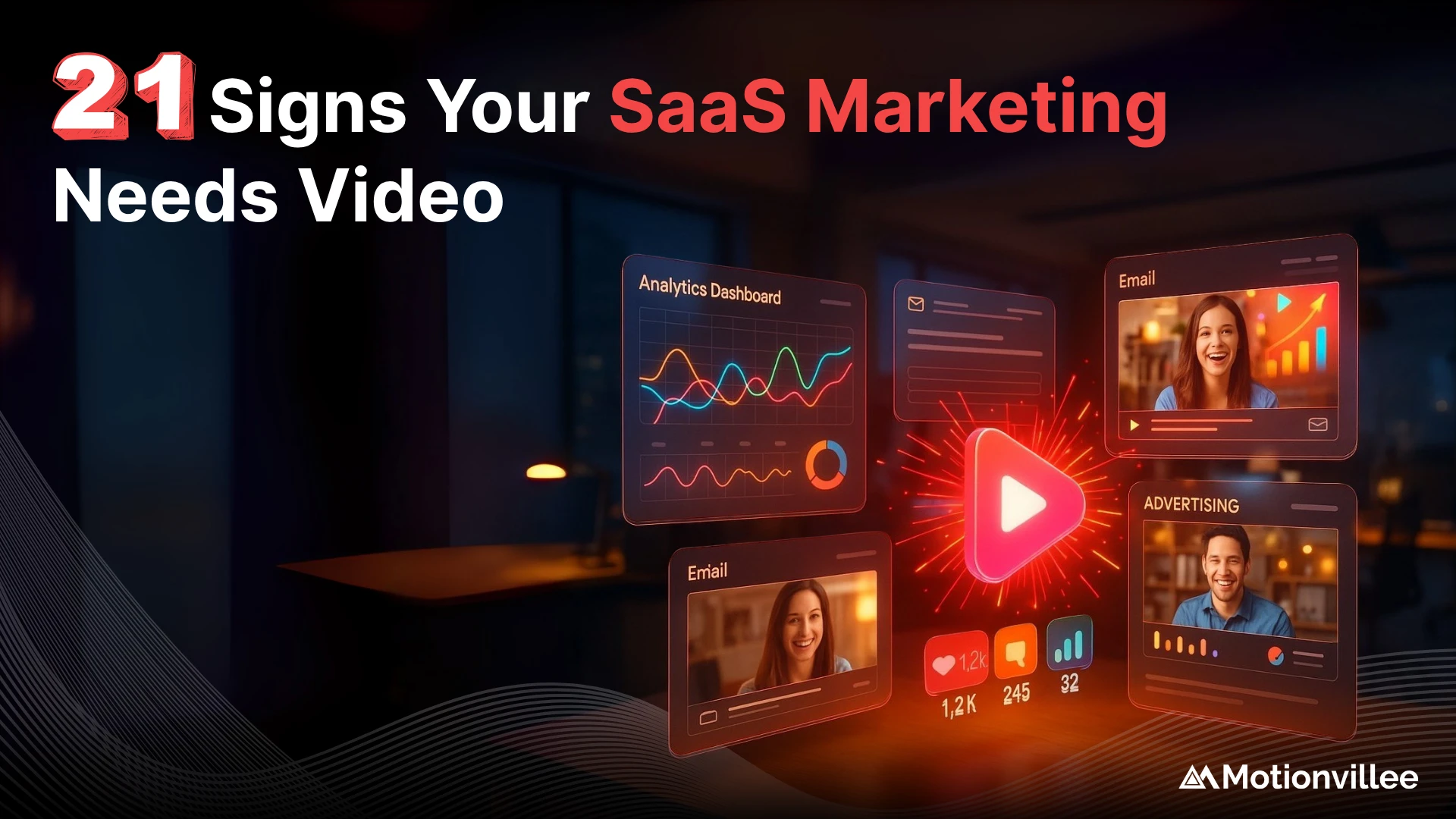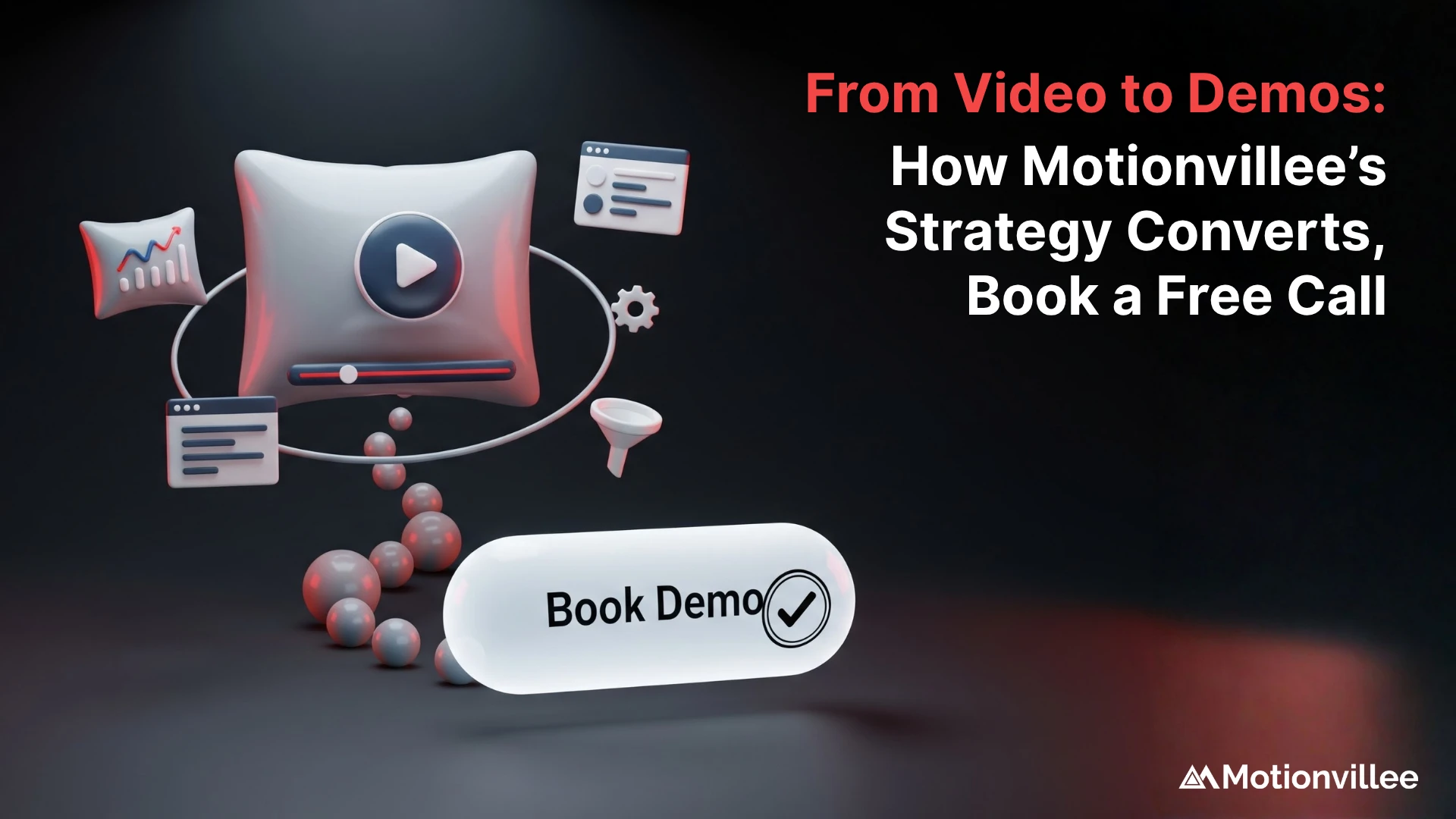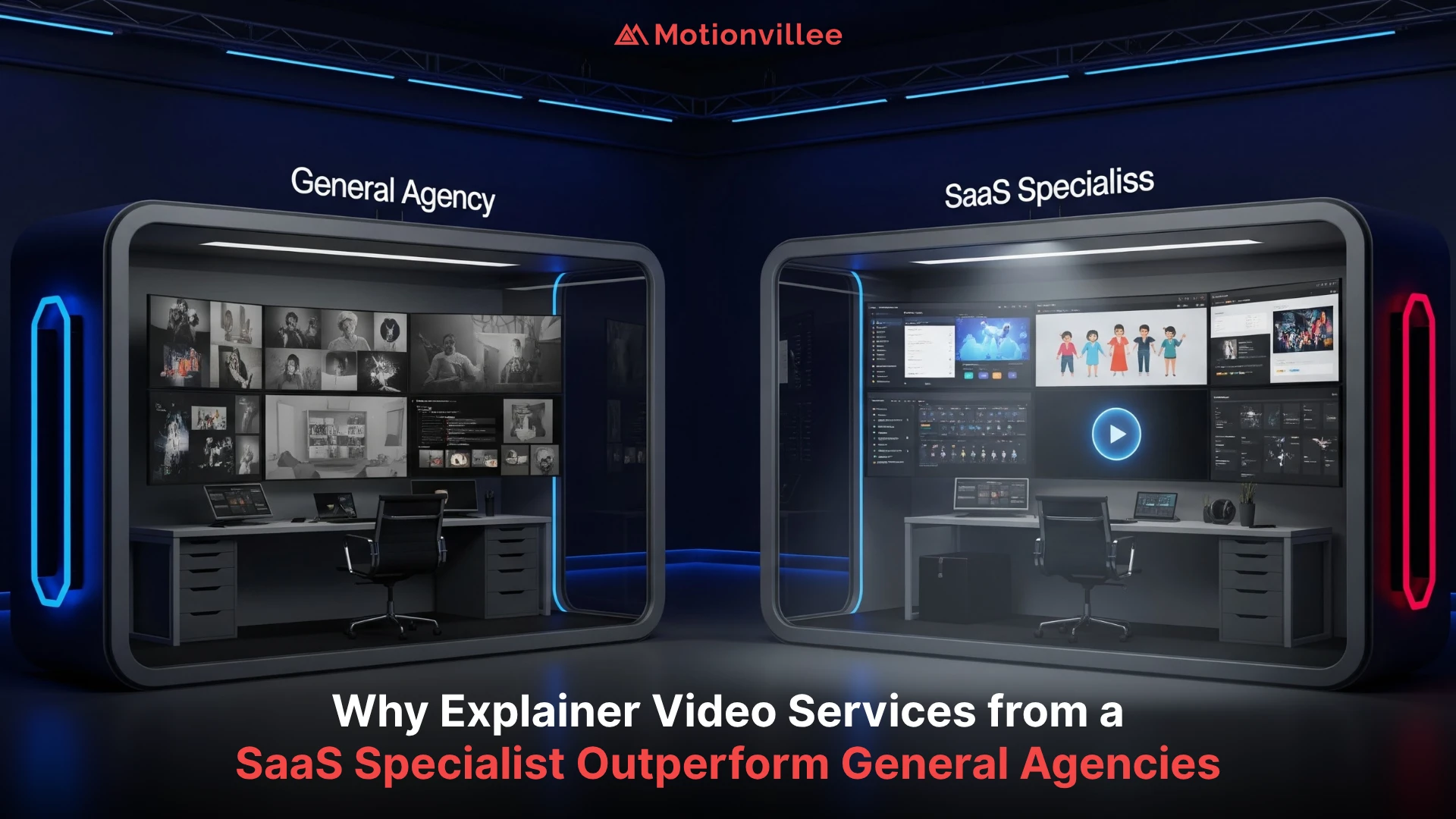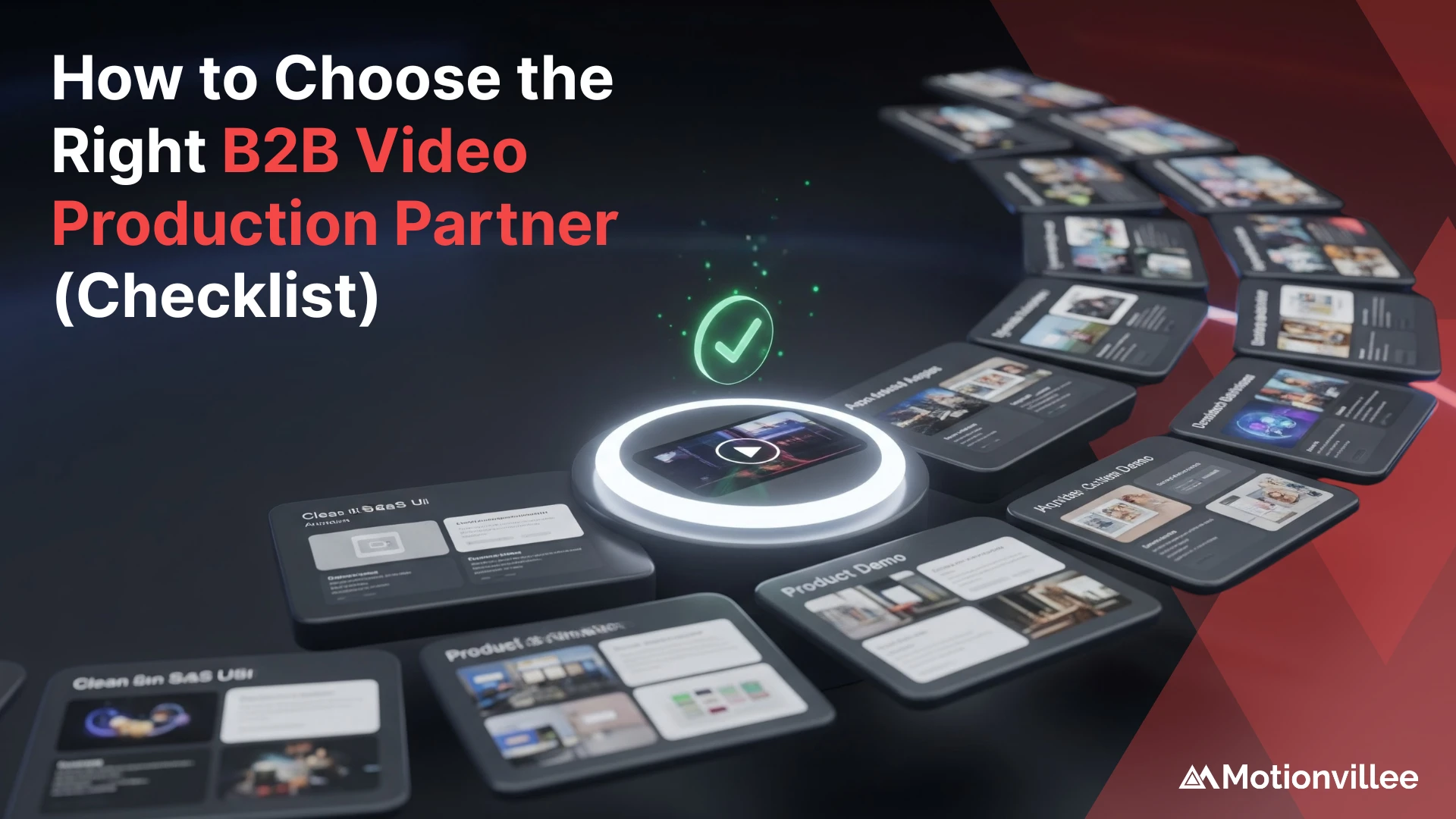Your Competitors Are Already Using Video. Here’s How to Know If You’re Falling Behind
You keep hearing about video marketing, but it feels like another expensive distraction. Your SaaS needs video marketing eventually, maybe, but right now you’re focused on fundamentals: product development, sales execution, and keeping customers happy.
Except competitors are using video to close deals faster, educate prospects more efficiently, and build brands that stick in buyers’ minds. The question isn’t whether you need a SaaS video marketing strategy. It’s whether you can afford to delay any longer.
This post identifies 21 specific indicators that show when video becomes essential, not optional. These aren’t vague suggestions. They’re measurable problems happening in your business today that video solves more effectively than any other medium. If you’re experiencing five or more of these signs, video has moved from optional to essential.
What Makes Video Essential for SaaS Marketing Today?
Video is no longer optional for SaaS companies because buyers expect to see your product in action before talking to sales.
The B2B buying process has fundamentally changed. Decision makers now complete 70% of their purchase journey before contacting a sales rep. They’re researching independently, comparing options, and forming opinions without your input. If you’re not showing them what your software does, they’re moving to competitors who do.
SaaS products are inherently difficult to explain through text alone. You’re selling workflows, interfaces, and outcomes that prospects need to visualize. Video marketing for SaaS bridges this gap instantly by demonstrating rather than describing.
Video shortens sales cycles by handling education upfront. When prospects arrive at sales conversations already understanding your product’s value, your team spends less time on basic explanations and more time closing. This compression directly impacts revenue velocity.
The competitive reality is stark. B2B video marketing is now standard practice among successful SaaS companies. If your homepage lacks a SaaS explainer video, if your sales team lacks demo assets, if your onboarding relies entirely on written documentation, you look outdated compared to competitors who’ve modernized.
Modern buyers prefer video over text. Studies consistently show prospects would rather watch a short product video than read lengthy explanations. When you force them to consume information in less efficient formats, you’re creating friction that benefits competitors.
Is Your Website Failing to Convert Visitors?
If visitors leave your website without understanding your product or booking demos, your site lacks the visual clarity that video provides.
Your website exists to convert traffic into pipeline. When it fails at this fundamental job, you’re wasting every dollar spent driving visitors there. High traffic with low conversion doesn’t indicate a marketing problem. It indicates a communication problem that a SaaS explainer video solves immediately.
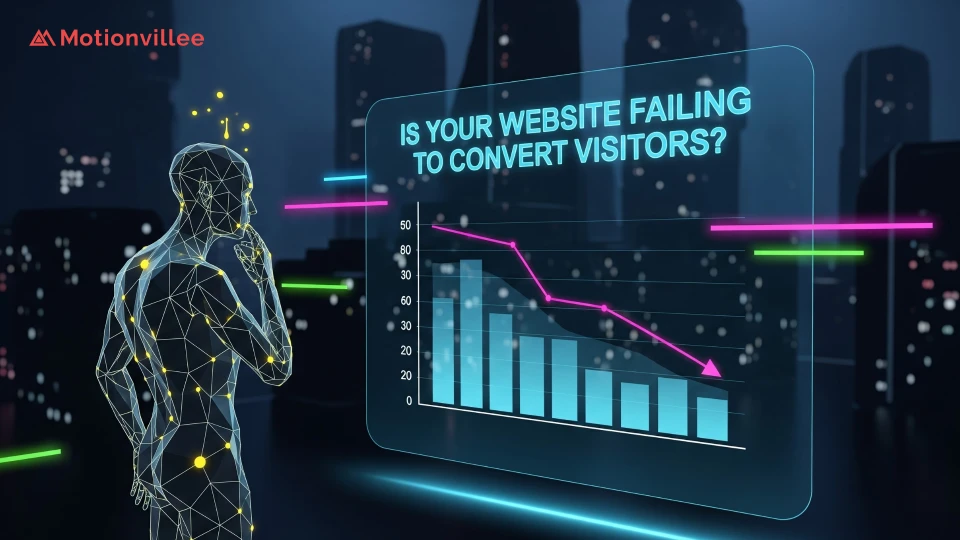
Signs 1-5: Your Website Needs Video
1. Your Homepage Bounce Rate Is Above 60%
A bounce rate above 60% means most visitors take one look at your homepage and leave. They’re not scrolling, not clicking, not exploring. This happens when visitors can’t quickly grasp what you do or why it matters.
Text heavy homepages require too much effort. Visitors won’t read three paragraphs to understand your value proposition when they can watch a 90 second video that shows them instead. The cognitive load difference is substantial, and visitors always choose the path of least resistance.
2. Demo Request Forms Get Views But No Submissions
Visitors are interested enough to click through to your demo request page, but something stops them from filling out the form. This gap indicates uncertainty. They’re not confident enough in what they’ve learned to commit to a sales conversation.
A product demo video on that page answers their remaining questions and builds the confidence needed to convert. Demo request conversion improves dramatically when prospects can see your product before requesting more information. You’re asking for commitment before providing clarity, and that sequence fails consistently.
3. Visitors Spend 2+ Minutes on Pages But Don’t Take Action
Google Analytics shows decent time on page, suggesting engagement, but no conversions follow. Visitors are searching for information your site isn’t providing clearly. They’re scrolling through feature lists, reading benefit statements, trying to piece together a mental picture of your product.
This behavior screams for visual demonstration. When visitors work this hard to understand what you do, most will simply leave and evaluate competitors with clearer positioning. The effort gap between reading and watching creates friction you can’t afford in a competitive market.
4. Your Pricing Page Has the Highest Exit Rate
Prospects make it all the way to pricing, indicating real interest, then abandon the site. This pattern reveals a value perception problem. They see your price but don’t fully understand the product’s scope or impact, making cost feel unjustified.
Video content placed strategically before or on the pricing page reinforces value by showing comprehensive functionality, real use cases, and tangible outcomes. When prospects clearly see what they’re paying for, price becomes less of a barrier. The video conversion rate improvement on pricing pages typically ranges from 30-60% because visual context transforms price from a barrier into a justified investment.
5. Sales Calls Start With “So, What Exactly Does Your Product Do?”
If prospects book calls without basic product understanding, your website failed its primary educational job. Sales reps shouldn’t spend the first 15 minutes of every call explaining fundamentals. That’s inefficient for everyone and signals your site lacks clarity.
A homepage explainer video ensures prospects arrive at conversations already informed, letting your team focus on fit, customization, and closing instead of basic education. This efficiency gain compounds across hundreds of sales conversations annually.
Is Your Sales Team Wasting Time on Repetitive Demos?
When your sales team spends excessive time explaining basic product functionality or qualifying unfit leads, video can handle education earlier in the funnel.
Your sales team’s time is your most expensive resource. Every hour spent on repetitive explanations or unqualified prospects is an hour not spent closing ready buyers. If your reps do the same product demo five times daily or answer identical questions in every discovery call, you’re burning budget on activities that a SaaS product demo video handles more efficiently.
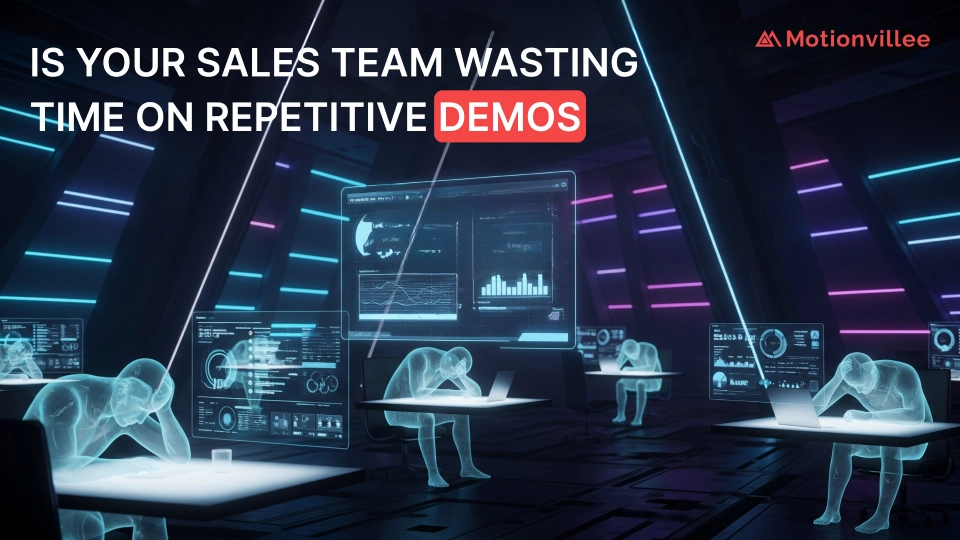
Signs 6-10: Your Sales Process Needs Video
6. Sales Reps Give the Same Product Demo 5+ Times Per Day
Repeating identical product demonstrations is the clearest sign your sales process needs video intervention. Your reps are essentially human playback devices, showing the same features in the same order to prospects at similar stages. This approach doesn’t scale, exhausts your team, and delivers inconsistent messaging.
A professionally produced SaaS product demo video ensures every prospect sees your best presentation every time. It frees your team to focus on strategic conversations that actually require human expertise. The efficiency gain is immediate and measurable in hours reclaimed weekly.
7. Your Average Sales Cycle Exceeds 90 Days
Extended sales cycles often result from product complexity that creates decision paralysis. Prospects need multiple touchpoints to fully understand your solution, and each meeting adds weeks to the timeline. Sales cycle video assets compress this education phase dramatically.
When prospects can watch detailed product walkthroughs, feature explanations, and use case demonstrations on their own schedule, they move through evaluation stages faster. Companies implementing video in their sales process typically see 30-50% reductions in time to close because education happens asynchronously rather than through scheduled meetings.
8. 40%+ of Qualified Leads Go Cold After First Call
Leads that seemed promising suddenly go silent after initial conversations. This drop off often indicates they didn’t fully grasp your product’s value or forgot key details between meetings. Without reinforcement, your pitch fades from memory as they evaluate multiple solutions simultaneously.
Follow up emails with a product walkthrough video keep your solution top of mind and provide an easy way for prospects to refresh their understanding. They can also share these videos with other decision makers internally, expanding your reach within accounts without requiring additional sales meetings.
9. Prospects Ask “Can I See It First?” Before Scheduling Calls
Modern buyers want to self educate before committing calendar time to vendor meetings. When prospects repeatedly request to see your product before booking calls, they’re telling you exactly what’s missing from your marketing. They want video demonstrations available on demand.
Meeting this expectation with a product demo on your website qualifies leads automatically. Prospects who watch and still request meetings arrive more informed and further along in their decision process. This self qualification improves sales efficiency by ensuring your team spends time with genuinely interested, educated prospects.
10. Every Rep Has Their Own Demo Deck or Slides
Inconsistent sales materials indicate a lack of standardized, high quality assets your team can rely on. When reps create their own demos, you get wildly variable quality and messaging. Some reps are naturally better presenters. Others miss key selling points or misrepresent features.
Professional product demo video provides consistency that ensures every prospect receives the same polished, on brand experience. This standardization protects your brand, ensures accurate messaging, and removes the variability that comes from relying on individual rep skills and preparation levels.
Is Your Content Marketing Actually Generating Leads?
If your blog posts and written content aren’t driving engagement or conversions, you’re missing the visual component that makes complex SaaS concepts digestible.
Content marketing for SaaS companies faces a unique challenge. You’re trying to explain technical products, complex workflows, and abstract value propositions through text alone. Even well written blog posts struggle to hold attention when readers need to visualize concepts. When your SaaS content marketing generates traffic but no business outcomes, video content fills the gap.
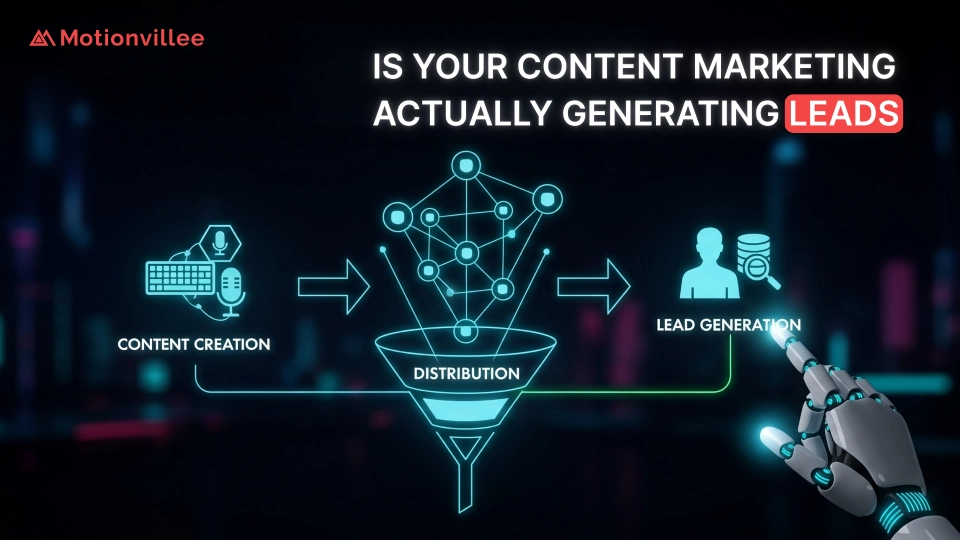
Signs 11-15: Your Content Strategy Needs Video
11. Blog Posts Get Traffic But Average Read Time Is Under 60 Seconds
Your SEO is working. You’re ranking for relevant keywords and driving organic traffic. But visitors hit your blog posts and bounce almost immediately. Average read times under 60 seconds mean people aren’t actually consuming your content.
They’re scanning, finding it too dense or text heavy, and leaving. SaaS marketing video content embedded in blog posts captures attention that pure text can’t hold. Readers who won’t wade through 2,000 words will gladly watch a 3 minute video covering the same topic because video reduces cognitive effort.
12. Your Content Has High Views But Zero Demo Requests
Awareness without conversion is a common content marketing trap. Your posts rank well, generate impressions, maybe even get shared. But none of this activity translates to pipeline. The disconnect happens because written content educates but doesn’t demonstrate.
Readers learn about concepts without seeing your actual product in action. Adding video content to high traffic posts creates a bridge from education to evaluation. Show readers how your product delivers on the concepts you’re explaining, and include clear calls to action that move them toward demos.
13. Technical Feature Explanations Require 2,000+ Word Blog Posts
When you need thousands of words to explain a single feature, you’re fighting the limitations of text. Complex technical concepts that take pages to describe become immediately clear in short video demonstrations. This isn’t a writing quality issue. It’s a medium mismatch.
Some information simply communicates better visually. If your posts consistently exceed 2,000 words because you’re trying to paint detailed pictures with text, you’re working harder than necessary. Video makes these explanations effortless and more engaging for your audience.
14. LinkedIn and Social Posts Get Minimal Engagement
Social media algorithms heavily favor video content. Posts with video get 5-10x more engagement than text or static images because platforms prioritize formats that keep users on site longer. If your LinkedIn posts generate minimal likes, comments, or shares, you’re losing the algorithmic lottery.
Video content performs exponentially better on every major platform. This isn’t opinion. It’s measurable reality backed by platform data and engagement metrics across millions of posts. Text based content simply can’t compete in algorithm driven feeds.
15. Competitor Video Content Ranks Above Your Written Guides
You’ve invested in comprehensive written guides, but competitors with shorter video tutorials outrank you in search results. Google increasingly favors video content because users engage with it longer. Video results often appear in featured snippets and answer boxes that push traditional blog posts down.
When competitor video content consistently outperforms your written resources, you’re ceding valuable search real estate. The solution isn’t better writing. It’s adding video to your content strategy to match what search engines reward and users prefer.
Are You Losing Deals to Competitors With Better Video?
When prospects mention seeing competitor videos or your win rate drops against companies with strong video presence, you’re losing deals to better visual communication.
Competitive losses hurt most when you know your product is superior. You have better features, stronger support, more reasonable pricing. Yet prospects still choose competitors. Often the differentiator isn’t product quality. It’s communication quality. Companies with strong B2B video marketing present their solutions more compellingly.
Signs 16-19: Your Competitive Position Needs Video
16. Prospects Mention Competitor Names More Often in Discovery Calls
When prospects reference competitors unprompted during early conversations, those brands have achieved top of mind awareness yours lacks. This advantage often comes from memorable video content prospects discovered during research. A compelling explainer video or customer story sticks in memory far better than a written case study.
If your brand isn’t mentioned in the same breath as competitors, you’re not breaking through the noise. Video creates memorable brand moments that text based marketing can’t replicate. The emotional and visual impact of video builds stronger recall than any amount of written content.
17. Sales Hears “We Watched Their Product Video” During Evaluations
This phrase should trigger immediate alarm. Prospects are explicitly telling you they consumed competitor video content, found it valuable, and used it in their evaluation process. Meanwhile, you’re asking them to schedule meetings, sit through sales pitches, or read documentation to understand your product.
The friction difference is enormous. Buyers always choose the path of least resistance. Competitor video content provides easier, faster product education than your current approach. Every time you hear this phrase, you’re learning about a deal lost to better communication rather than better product features.
18. Your Brand Feels Dated Compared to Newer Competitors
Brand perception isn’t always about age. It’s about presentation. Newer SaaS companies frequently launch with video first marketing strategies because they understand modern buyer expectations. Your company might have years of market experience, but if your website lacks video while competitors lead with it, you appear behind the times.
This perception problem directly impacts deal velocity. Buyers associate modern presentation with modern products, even when that association isn’t technically accurate. First impressions matter enormously in crowded markets, and video creates stronger, more favorable first impressions than text and static images.
19. Prospects Can’t Remember Your Product Name After Trade Shows
You invest thousands in conference booths, generate decent foot traffic, collect business cards, then follow up to discover prospects barely remember meeting you. Trade show amnesia happens when you don’t create distinctive, memorable moments. Static booth displays and verbal pitches fade quickly.
Competitors showing engaging product videos at their booths create lasting impressions because video combines visual, auditory, and emotional elements. Multiple sensory inputs build stronger memory formation than conversation alone. If your trade show ROI disappoints, lack of competitor video content at your booth is likely a contributing factor.
Is Your Customer Success Team Drowning in Support Tickets?
High support ticket volume and slow onboarding indicate customers don’t understand your product, and video training and documentation reduce these issues significantly.
Customer success costs are often hidden indicators of poor product communication. When your support team fields repetitive questions or new customers struggle through onboarding, you’re paying for communication failures. Customer onboarding video and training video content solve these problems more effectively than written documentation because they show rather than tell.
Signs 20-21: Your Customer Experience Needs Video
20. Support Receives the Same 10 Questions Every Week
Repetitive support tickets represent expensive inefficiency. Your team answers identical questions dozens of times monthly, questions that shouldn’t require human intervention. This pattern indicates documentation gaps or, more likely, documentation that customers don’t use because reading help articles takes more effort than submitting tickets.
Customer onboarding video tutorials eliminate this problem by providing visual, easy to consume answers. Customers will watch a 2 minute video but won’t read a 1,000 word help article. The effort gap matters significantly in whether customers self serve or contact support.
Companies implementing video based help centers typically see 30-40% reductions in support ticket volume. Each prevented ticket saves both support costs and customer frustration. Calculate your average cost per support interaction, multiply by preventable tickets, and you’ll quickly justify the investment in training video content.
21. New Customers Take 60+ Days to Reach Full Platform Adoption
Long onboarding timelines delay value realization and increase churn risk. Customers who don’t quickly adopt your product’s full functionality are more likely to cancel because they’re not experiencing complete value. This adoption friction often stems from overwhelming written documentation that customers find difficult to navigate.
They use basic features and never progress to advanced capabilities that would make them stickier customers. Video based onboarding compresses time to value by showing customers exactly how to use advanced features in context. Instead of reading through setup guides, they watch workflows demonstrated step by step.
This visual learning accelerates comprehension and builds confidence. Companies replacing text heavy onboarding with video tutorials see adoption timelines compress by 40-60%, getting customers to full product usage faster and reducing early stage churn. The customer success investment in video pays dividends throughout the entire customer lifecycle.
What Types of SaaS Videos Should You Create First?
Start with explainer videos and product demos, then expand to customer testimonials and feature spotlights based on your specific pain points from the 21 signs.
Not all video types deliver equal value. Your first videos should address your most pressing problems identified in the signs above. If website conversion is your biggest issue, start with a homepage SaaS explainer video. If sales efficiency is the problem, prioritize a product demo. Strategic prioritization ensures your initial investment delivers maximum ROI.
Homepage explainer videos solve awareness and clarity problems. These 60-90 second videos answer three critical questions: what you do, who it’s for, and why it matters. A strong explainer reduces bounce rates and moves visitors deeper into your funnel.
Product demo videos enable sales efficiency and self service evaluation. These 2-5 minute walkthroughs show your product’s core functionality and primary value propositions. Sales teams use them to qualify leads. Prospects watch them independently to evaluate fit.
Tutorial and training videos reduce support burden and accelerate onboarding. These focused videos teach specific features and workflows. Create them for your most frequently asked support questions. Companies experiencing signs 20-21 should invest here after covering awareness and sales basics.
Customer testimonial videos build trust and social proof. Video testimonials SaaS companies use differ from written case studies by capturing emotion and authenticity that text can’t convey. Prospects believe other customers more than they believe you.
Professional SaaS video production ensures these assets are high quality, on brand, and optimized for their purposes. Poor quality video often performs worse than no video because it damages credibility. Most SaaS companies should plan for 3-5 core video assets in year one: one explainer, one full product demo, 2-3 feature demos, and 1-2 customer testimonials.
How Much Should SaaS Companies Invest in Video Marketing?
Budget 5-15% of your marketing budget for video, with initial investment focused on core assets that solve your most pressing signs.
Video marketing budget questions stress many SaaS leaders because pricing varies enormously. You can spend $5,000 or $50,000 on an explainer video depending on quality and length. The right marketing video investment depends on your revenue stage and how many signs you’re experiencing.
Early stage startups under $1M ARR should allocate $15,000-$30,000 for initial video assets. This covers one strong explainer and one product demo. Growth stage companies $1M-$10M ARR typically invest $50,000-$150,000 annually across multiple video types. Established SaaS companies over $10M ARR often dedicate $200,000+ annually to comprehensive video programs.
Homepage explainer videos typically deliver 20-40% increases in demo requests. Sales enablement videos compress sales cycles by 25-50%. Training videos reduce support costs by 30-40%. These aren’t aspirational numbers. They’re industry benchmarks for video marketing ROI from companies that measure properly.
The cost of inaction often exceeds the video marketing budget. Calculate what you’re currently losing to inefficient sales processes, high bounce rates, support overhead, and lost competitive deals. If those losses exceed $100,000 annually, a $30,000 investment in core video assets represents a fraction of your problem’s actual cost.
Begin with one high impact video that addresses your most pressing sign. Measure its performance rigorously through conversion rates and sales feedback. Use this data to justify expanding your video marketing for SaaS based on proven ROI rather than faith.
What ROI Can You Expect from SaaS Video Marketing?
SaaS companies typically see 20-40% increases in demo requests, 30-50% shorter sales cycles, and 2-3x higher email click through rates when implementing strategic video content.
Video marketing ROI for SaaS is measurable across every funnel stage. Unlike brand awareness campaigns with fuzzy attribution, SaaS video performance is tracked directly through website analytics, CRM data, and sales feedback. Companies that approach video strategically see consistent improvements in metrics that matter.
Adding video to landing pages increases conversion rates by 20-80% depending on the page and video quality. Homepage explainer videos typically boost demo request rates by 25-40%. Product pages with demo videos see 30-60% higher signup conversion. These improvements aren’t marginal. They’re transformational for pipeline generation.
Email campaigns that include video see 2-3x higher click through rates compared to text only emails. The word “video” in an email subject line alone can increase open rates by 19%. Prospects are more likely to engage with video content than read lengthy email copy.
Companies implementing video in their sales process report 30-50% reductions in time to close. This compression happens because prospects arrive at sales conversations already educated. Shorter sales cycles improve revenue velocity and let your team close more deals with the same resources.
Video based help centers and onboarding programs reduce support ticket volume by 30-40%. Each prevented ticket saves both direct support costs and customer frustration. Time to value improves dramatically with video onboarding. Customers who complete video based training adopt features 40-60% faster than those relying on written documentation.
When video improves conversion rates throughout your funnel, your customer acquisition cost decreases proportionally. This improvement compounds over time as more prospects engage with your SaaS video assets.
Don’t Wait Until Your Competitor’s Video Goes Viral
Your SaaS needs video marketing if you’re experiencing even five of these 21 signs.
Website signs (1-5) indicate visitors don’t understand your product. Sales signs (6-10) show your team drowning in repetitive education. Content signs (11-15) reveal written marketing isn’t engaging audiences. Competitive signs (16-19) mean better visual communication wins deals. Customer success signs (20-21) prove documentation isn’t working.
These aren’t isolated problems. They’re interconnected symptoms of inadequate visual communication. Each sign costs you revenue through lost deals, inefficient processes, or preventable churn. Multiple signs compound these losses and indicate urgent need for video intervention.
Video isn’t a nice to have feature. It’s a competitive necessity in modern SaaS marketing. Your prospects expect it. Your competitors use it. Your metrics suffer without it. The question isn’t whether to invest in video. It’s whether you can afford to keep delaying while your SaaS needs video marketing becomes more urgent.
Companies that embrace video early build compounding advantages. Better conversion rates generate more pipeline. Shorter sales cycles let teams close more deals. Reduced support costs free resources for growth. These benefits accumulate year over year, widening the gap between video adopters and companies still relying on text based marketing.
Ready to stop losing ground to competitors? Schedule a call with Motionvillee to assess which video assets will deliver the biggest impact for your specific signs. We’ll help you prioritize investments that solve your most pressing challenges and build a video marketing strategy that drives measurable business results.


